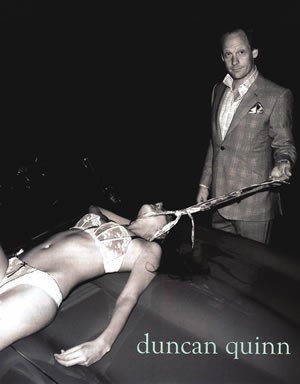From my point of view as a young woman, this advertisement for the New York suit designer Duncan Quinn is disturbing and highly offensive. It was published in 2008 as the first campaign used to promote the brand, immediately reflecting their motive to associate with a target market of ‘gentlemen and rogues’ (Duncan Quinn, 2017). This sarcastic description leads me to assume that the violent content of the image is designed to be amusing or even attractive as an idea to their powerful, wealthy male customers. With this in mind, the effortlessly classy look of the actor falsely and inappropriately advertises that wearing a Duncan Quinn suit will allow the wearer to exert complete control over women. This could be viewed as an example of male chauvinism, highlighting the ethical issues around presenting male domination within the media.
The photograph depicts this alpha-male type character standing over a young woman, who is laid in a pool of blood, with his tie tied around her neck. From this scene one makes the assumption that this gentleman has just violently murdered and even perhaps sexually abused or raped the vulnerable female. The actor exudes complete masculine control not only through the hierarchical positioning standing over the woman but also through physically forcing her to look up at him using his tie. This metaphorically stresses his male omnipotence in the situation especially because his gaze is directed towards the camera which implies a lack of genuine interest in her. This is further reinforced by the smug look on the actor’s face suggesting his amusement at the situation almost as if the serious ethical matter of violence and murder is trivial. In my opinion, presenting violence within the media is a highly inappropriate and serious matter because ‘it condones violent attitudes and behavior and contributes to exaggerated fear of violence among those encouraged to see themselves as its potential victims’ (Kay Weaver, 2003).
Similarly, the content of this advertisement also highlights the issue around presenting demeaning female stereotypes within the media. Women are often devalued and dehumanized by the mass media and presented as passive, innocent beings, as demonstrated in this photograph. The choice of camera angle here visually focuses on the actress’s body and conceals her facial features; in this way women are conveyed as mere sexual objects with no individuality. Furthermore, the idea of female vulnerability is clearly reinforced by the woman’s unconscious state particularly given the revealing underwear she is wearing. Elizabeth Wilson explains how underwear is associated with ‘sexuality and eroticism’ (Wilson, 1985: 106) and thus one could conclude that this advertisement inappropriately presents women as male-dominated sex toys.
Finally, through presenting a stereotypically slim and youthful actress as an example of an attractive female, Quinn’s advertisement raises the controversial ethical issue of ‘the cult of the slender figure’ (Wilson, 1985: 114). As is often presented in the media, this woman’s physique is an unrealistic ideal for most females in our current society. Moreover she is clearly much younger than the actor and this reflects the stereotype that men are predominantly attracted to young women. This inescapable and often unachievable vision of beauty that is broadcasted by the media, for example in this advertisement, leads to the oppression of women by society (Wilson, 1985: 115).
References:
BuzzFeed Staff (2013). The Violent Exploitation Of Women In Fashion Continues…. [online] BuzzFeed. Available at: https://www.buzzfeed.com/copyranter/violence-against-women-in-fashion-continues-unabated?utm_term=.rkLgdyQg6#.vjE82mL8E [Accessed 22 Nov. 2017].
Duncan Quinn. (2017). About. [online] Available at: http://duncanquinn.com/about/ [Accessed 22 Nov. 2017].
Kay Weaver, C. (2003). Violence: Dr C Kay Weaver on violence as an advertising and marketing strategy. (Advertising).. [online] Business.highbeam.com. Available at: https://business.highbeam.com/6504/article-1G1-105368567/violence-dr-c-kay-weaver-violence-advertising-and-marketing [Accessed 24 Nov. 2017].
Wilson, E. (1985) Adorned in Dreams: Fashion and Modernity, London. Virago

